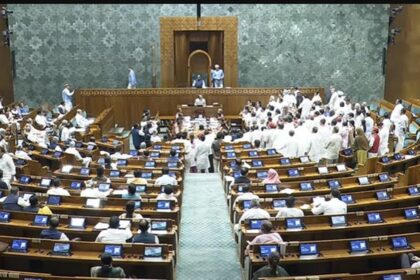Language, Law, and Identity—Mumbai’s Marathi Signboard Mandate
In a bold administrative move that blends civic enforcement with linguistic identity, the Brihanmumbai Municipal Corporation (BMC) has doubled down on its mandate for the use of Marathi in commercial signage across the city. The civic body has officially declared that shops and commercial establishments failing to display signboards in Marathi will face a significant financial penalty—doubling of property tax—and, in more severe cases, cancellation of their operational licenses. This initiative, long in the making, has now entered a more aggressive phase of enforcement.
The BMC’s order comes under the provisions of the Maharashtra Shops and Establishments Act, which mandates that the name boards of all establishments must display their names in Marathi (Devanagari script) predominantly. While this rule has been on paper for years, its enforcement had remained inconsistent, often diluted by political pressures and bureaucratic laxity. That status quo is now being decisively challenged.
In recent months, the civic body began issuing direct notices to shopkeepers and commercial unit owners, particularly in prominent non-Marathi-dominated markets such as Bandra, Andheri, Colaba, and South Mumbai. With a sharp deadline in place and fines escalating swiftly, the BMC’s crackdown is seen as part of a broader political signal to prioritize the state language and assert its presence in the increasingly multilingual, globalised urban fabric of Mumbai.
Officials within the BMC have stated that the enforcement drive is not merely about language—it is about “preserving the cultural identity of Maharashtra within its financial capital.” However, critics argue that the initiative risks alienating a significant section of Mumbai’s commercial community, which comprises diverse linguistic and regional backgrounds including Gujarati, Hindi, Marwari, Tamil, and even international businesses that often display signage only in English.
From the BMC’s perspective, the doubling of property tax is an instrument of both deterrence and accountability. For business owners, especially those running medium and large establishments in prime commercial real estate zones, the increased taxation could mean lakhs in additional costs. More worryingly, the ultimate threat—license cancellation—could render an establishment non-operational and legally noncompliant.
At the heart of this regulatory offensive lies a sensitive cultural question: In a city as cosmopolitan as Mumbai, how does one strike the balance between respecting local identity and fostering a multilingual, inclusive economic environment? The answer, for now, appears to be taking shape not through dialogue, but via administrative fiat.
The Maharashtra Navnirman Sena (MNS), a political party known for its aggressive Marathi pride campaigns, has been a vocal supporter of the measure. Party workers have not only welcomed the BMC’s enforcement but have also taken to the streets to publicly identify and “name and shame” businesses that do not comply. Videos and images of such actions have gone viral, leading to both praise and criticism online. While some see this as necessary activism, others view it as cultural vigilantism disguised as civic duty.
BMC insiders have revealed that a centralized task force has been formed, with zonal teams tasked to inspect compliance across Mumbai’s 24 administrative wards. Each team is responsible for verifying signboards, documenting non-compliance, issuing penalty notices, and forwarding serious violators for license review. Data collected so far indicates that thousands of shops have either hastily changed their boards or have filed for extensions, citing logistical challenges.
As Mumbai’s commercial hubs respond to this growing pressure, legal experts have begun weighing in on the constitutional aspects of the directive. While state governments do have the power to legislate in areas concerning commerce and language under the Concurrent List, the penal nature of the enforcement—particularly license cancellation—may soon be challenged in courts under Article 19 (freedom to practice any profession or to carry on any occupation, trade or business) and Article 14 (equality before the law).
Yet, despite the legal and political noise, the BMC remains firm. Senior officials have emphasized that this is not a campaign for suppression, but one for inclusion. “Marathi isn’t just a language. It is the voice of this land,” said a senior civic officer in a press briefing. “Our signage policy is not against any language—it is for Marathi.”
For many observers, the larger story here is not just one of fines or signboards. It is about the evolving identity of Mumbai—a city that constantly oscillates between its Marathi roots and its global aspirations. And in this oscillation, policy decisions such as these are both reflective of underlying tensions and predictive of future political trends.
In the coming parts of this article, we will explore the historical context of language politics in Mumbai, the legal architecture underpinning civic language mandates, reactions from trader associations, responses from non-Marathi communities, and the potential long-term implications on the city’s socio-economic harmony.
To fully grasp the intensity and implications of the BMC’s present-day crackdown on shops without Marathi signboards, one must delve into the deep historical currents that have shaped Mumbai’s sociolinguistic landscape. This is not merely an administrative or political act—it is part of a continuum of identity politics that has defined Maharashtra’s relationship with its capital city for decades.
Mumbai, formerly Bombay, has always been a city of immigrants. From the late 19th century, waves of Gujaratis, Marwaris, Parsis, South Indians, and later North Indians came to this port city in search of livelihood and opportunity. As textile mills flourished and trading businesses expanded, the city’s economic base grew increasingly non-Marathi in its leadership, management, and financial ownership. By the 1950s, this trend had become both visible and contentious.
The creation of the state of Maharashtra in 1960, after a fierce Samyukta Maharashtra movement demanding a Marathi-speaking state, was a landmark moment. But even then, the central irony remained—Mumbai, Maharashtra’s capital, did not reflect the linguistic dominance of the state’s majority population. This paradox sowed the seeds for political movements that would erupt with greater force in the following decades.
In 1966, the Shiv Sena emerged under the leadership of Bal Thackeray. The party was born with a singular slogan—“Marathi Manoos First.” The demand was clear: Maharashtrians must not become second-class citizens in their own capital. From demanding employment reservation in private sector jobs for locals to targeting non-Marathi business owners, the Shiv Sena’s early days were deeply rooted in linguistic and cultural assertiveness.
Language, in particular, became a crucial symbol. The use of English and Hindi in official communication and public-facing business signage was viewed as erasure of the Marathi ethos. It was during this period that the push for Marathi signboards first gained momentum, even though actual implementation remained sporadic.
Over the years, the demand for linguistic visibility grew louder. And while political discourse shifted to accommodate national issues, regional pride never left the radar. The Maharashtra Shops and Establishments (Regulation of Employment and Conditions of Service) Act of 2017 formalized what had previously been a cultural aspiration: that all commercial signage must prominently display their name in Marathi (in the Devanagari script).
However, even after legal backing, compliance remained patchy. Multinational corporations, luxury retail outlets, and even small-scale local traders often chose aesthetic over adherence. English-only signage became synonymous with elite branding, pushing Marathi into the background. Enforcement agencies frequently looked the other way, and political will ebbed and flowed depending on electoral calculations.
That backdrop makes the BMC’s recent aggressive push all the more significant. It signals not just a policy revival, but a strong assertion of linguistic nationalism. Importantly, this wave is not confined to one political party. Both the Shiv Sena factions (Eknath Shinde’s and Uddhav Thackeray’s), as well as the MNS led by Raj Thackeray, have endorsed the campaign. The BMC, now under direct pressure to act, appears to be executing its orders with unprecedented urgency.
This renewed enforcement has also coincided with larger political narratives. With elections around the corner and cultural identities once again dominating public discourse, language has become a rallying point. Politicians have taken to social media and public platforms to share their support for Marathi dominance in signage, framing it as a matter of pride rather than punishment.
Yet, this movement is not without its critics. Urban scholars and civil rights activists argue that Mumbai’s strength lies in its diversity. Imposing linguistic conformity, they say, might alienate large segments of the population, including those who have contributed immensely to the city’s growth. “Is language visibility more important than inclusive growth?” asked a professor of urban studies from Tata Institute of Social Sciences. “While local culture must be respected, coercion through taxation and license threats raises serious constitutional and ethical questions.”
Business associations have expressed concern as well. According to the Federation of Retail Traders’ Welfare Association, several small and medium businesses are now struggling to comply—not out of resistance, but due to logistical and financial constraints. “The order came with short notice. Many traders are already recovering from post-pandemic economic strain. Penalizing them immediately is unfair,” a representative said during a recent press interaction.
Interestingly, some businesses are attempting to adapt creatively. A number of stores, especially in South Mumbai, have started redesigning their signage to incorporate Marathi elegantly alongside English, often using stylized fonts and branding cohesion to maintain their corporate aesthetic while fulfilling civic requirements. This trend is a potential middle path—one that preserves linguistic respect without compromising on modernity.
Still, the tension remains. With property tax doubling and license cancellations looming, the crackdown has become a city-wide flashpoint. The stakes are no longer just about signs—they are about the future character of Mumbai. Will it continue to evolve as a melting pot of cultures with flexible identity markers, or will it return to a more defined, regional ethos?
In the following parts, this article will examine individual case studies—of shopkeepers who have been penalized, of legal firms preparing constitutional challenges, and of consumers reacting to the changes. We will also trace how similar linguistic enforcement has played out in other Indian cities like Bengaluru and Chennai, and what lessons Mumbai can learn from those experiences.
As the Brihanmumbai Municipal Corporation (BMC) continues its sweeping enforcement of the Marathi signboard mandate, the ground-level effects of this civic order are becoming increasingly evident across the city. From high-end commercial strips to local bazaars, the reactions from business owners, employees, legal professionals, and customers range from cautious compliance to open defiance—and in some cases, complete confusion.
The first wave of official BMC notices was issued in late June 2025, targeting establishments that had failed to display signboards in Marathi as per the guidelines laid out in the Maharashtra Shops and Establishments Act. Since then, over 10,000 businesses across Mumbai’s 24 administrative wards have either received warning letters or penalty notices. Property tax has already been increased for over 2,500 defaulters, and more than 300 shops are currently facing license scrutiny or suspension proceedings.
Case Study 1: A Colaba Boutique’s Tryst with Compliance
Neelam Shah, who runs a fashion boutique in Colaba catering to international tourists and South Mumbai’s elite, was taken aback when she received a notice stating that her store’s English-only signage violated civic norms. “We’ve been here for over 18 years and never had an issue. Our clientele is global, and we’ve always focused on brand consistency,” she explains.
When asked why she hadn’t updated the signboard earlier, Shah points to a lack of communication and unclear timelines. “We never received prior written warnings—just one sudden visit, a photo taken, and a notice delivered. The next week, our property tax was recalculated.”
Her team is now redesigning the board to integrate Marathi script stylishly alongside the original logo. “It’s not about resisting the language—we respect Marathi deeply. But these things take time and money. The BMC should have offered a grace period or partial subsidy.”
Case Study 2: The Small Retailer in Andheri
Mohammed Naeem, a kirana (grocery) store owner in Andheri West, had a different experience. A sole proprietor with limited resources, Naeem was handed a notice with a deadline of seven days to comply or face double taxation. “We can barely afford rent, electricity, and salaries. Now this? I had to borrow ₹3,000 just to get a basic Marathi board printed and installed overnight.”
Despite the hardship, Naeem sees the issue in a wider context. “We are in Maharashtra, and I understand the government’s intent. But implementation should be fair and sensitive to ground realities. You cannot penalize the poor the same way you treat a luxury outlet in Juhu.”
Legal Pushback Emerges
While small retailers scramble to comply, the legal community in Mumbai is beginning to raise constitutional and procedural objections. A group of senior advocates and public interest litigators has announced plans to file a writ petition in the Bombay High Court, challenging the punitive aspects of the order—particularly the doubling of property tax and license cancellations.
Advocate Sandeep Verma, one of the petitioners, states, “The use of Marathi in signage may be legally encouraged, but financial penalties and operational bans violate Article 19(1)(g) of the Constitution, which guarantees the right to practice any profession or run a business. Additionally, the BMC’s enforcement lacks uniform due process and transparency.”
Legal experts also point out inconsistencies in execution. In some cases, notices were reportedly issued without prior physical verification or follow-up inspection. Others allege bias in targeting only certain areas while affluent zones with obvious violations remain untouched.
The Politicisation of Compliance
As the matter gains legal traction, the issue has also taken on overtly political dimensions. The Maharashtra Navnirman Sena (MNS) continues to actively campaign for full Marathi signage enforcement, with party workers visiting marketplaces to check compliance. Videos of MNS members confronting shop owners and replacing English-only signs with Marathi ones have gone viral—generating applause in nationalist circles and deep concern among human rights groups.
Raj Thackeray, in a recent press statement, reinforced his party’s position: “This is not about punishing anyone. This is about respecting the land and language that has given us everything. Marathi must not be an afterthought in Mumbai—it must be front and center.”
However, opposition leaders have criticized the move, alleging that the timing is electorally motivated. “There are better ways to promote Marathi,” said a senior Congress MLA. “Instead of using threats and fines, why not incentivize compliance through branding support or tax rebates for those who voluntarily promote the language?”
Public Sentiment: Divided and Evolving
Among citizens, responses have been mixed. While some welcome the move as a long-overdue assertion of Maharashtra’s linguistic and cultural identity, others fear it may undermine Mumbai’s cosmopolitan character.
Ritika Bhargava, a marketing executive in Lower Parel, believes this is a necessary correction. “If you go to Chennai or Ahmedabad, you’ll see strong use of Tamil or Gujarati in public spaces. Why should Marathi be any less visible in its own capital?”
On the other hand, Samir Desai, a digital entrepreneur in Bandra, warns of the potential fallout. “What message are we sending to startups, international investors, or even domestic brands from other states? That compliance is driven not by good governance, but by coercion? That’s not a healthy business climate.”
BMC’s Response: “This Is Just the Beginning”
Officials from the BMC have dismissed claims of inconsistency or political targeting. In an official statement, a senior civic officer reiterated the administration’s intent: “This is not a campaign against English, Hindi, or any other language. This is a campaign for Marathi. Every other language is welcome—as long as Marathi is given its due prominence. Mumbai must reflect the linguistic soul of Maharashtra.”
The BMC has also indicated that this is just the beginning of a wider cultural compliance initiative. Discussions are underway to extend the Marathi mandate to digital displays, hoardings, and e-commerce storefronts operating within city limits.
Also Read : Eknath Shinde Steers the Future as Tesla Roars into Mumbai







